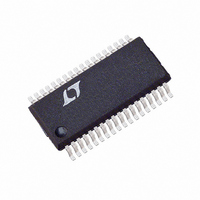LTC1709EG#TR Linear Technology, LTC1709EG#TR Datasheet - Page 15

LTC1709EG#TR
Manufacturer Part Number
LTC1709EG#TR
Description
IC REG SW 2PH SYNC STPDWN 36SSOP
Manufacturer
Linear Technology
Type
Step-Down (Buck)r
Datasheet
1.LTC1709EG.pdf
(28 pages)
Specifications of LTC1709EG#TR
Internal Switch(s)
No
Synchronous Rectifier
Yes
Number Of Outputs
2
Voltage - Output
1.3 ~ 3.5 V
Current - Output
3A
Voltage - Input
4 ~ 36 V
Operating Temperature
-40°C ~ 85°C
Mounting Type
Surface Mount
Package / Case
36-SSOP
Lead Free Status / RoHS Status
Contains lead / RoHS non-compliant
Power - Output
-
Frequency - Switching
-
Available stocks
Company
Part Number
Manufacturer
Quantity
Price
APPLICATIO S I FOR ATIO
output capacitor types. OPTI-LOOP compensation effec-
tively removes constraints on output capacitor ESR. The
impedance characteristics of each capacitor type are sig-
nificantly different than an ideal capacitor and therefore
require accurate modeling or bench evaluation during
design.
Manufacturers such as Nichicon, United Chemicon and
Sanyo should be considered for high performance through-
hole capacitors. The OS-CON semiconductor dielectric
capacitor available from Sanyo and the Panasonic SP
surface mount types have the lowest (ESR)(size) product
of any aluminum electrolytic at a somewhat higher price.
An additional ceramic capacitor in parallel with OS-CON
type capacitors is recommended to reduce the inductance
effects.
In surface mount applications, multiple capacitors may
have to be paralleled to meet the ESR or RMS current
handling requirements of the application. Aluminum elec-
trolytic and dry tantalum capacitors are both available in
surface mount configurations. New special polymer sur-
face mount capacitors offer very low ESR also but have
much lower capacitive density per unit volume. In the case
of tantalum, it is critical that the capacitors are surge tested
for use in switching power supplies. Several excellent
choices are the AVX TPS, AVX TPSV or the KEMET T510
series of surface mount tantalums, available in case heights
ranging from 2mm to 4mm. Other capacitor types include
Sanyo OS-CON, Nichicon PL series and Sprague 595D
series. Consult the manufacturer for other specific recom-
mendations. A combination of capacitors will often result
in maximizing performance and minimizing overall cost
and size.
INTV
An internal P-channel low dropout regulator produces 5V
at the INTV
regulator powers the drivers and internal circuitry of the
LTC1709. The INTV
peak and must be bypassed to power ground with a
minimum of 4.7 F tantalum or electrolytic capacitor. An
additional 1 F ceramic capacitor placed very close to the
IC is recommended due to the extremely high instanta-
neous currents required by the MOSFET gate drivers.
CC
Regulator
CC
pin from the V
CC
U
pin regulator can supply up to 50mA
U
IN
supply pin. The INTV
W
U
CC
High input voltage applications in which large MOSFETs
are being driven at high frequencies may cause the maxi-
mum junction temperature rating for the LTC1709 to be
exceeded. The supply current is dominated by the gate
charge supply current, in addition to the current drawn
from the differential amplifier output. The gate charge is
dependent on operating frequency as discussed in the
Efficiency Considerations section. The supply current can
either be supplied by the internal 5V regulator or via the
EXTV
is less than 4.7V, all of the INTV
by the internal 5V linear regulator. Power dissipation for
the IC is higher in this case by (I
efficiency is lowered. The junction temperature can be
estimated by using the equations given in Note 1 of the
Electrical Characteristics. For example, the LTC1709 V
current is limited to less than 24mA from a 24V supply:
Use of the EXTV
to:
The input supply current should be measured while the
controller is operating in continuous mode at maximum
V
vent the maximum junction temperature from being ex-
ceeded.
EXTV
The LTC1709 contains an internal P-channel MOSFET
switch connected between the EXTV
When the voltage applied to EXTV
internal regulator is turned off and an internal switch
closes, connecting the EXTV
thereby supplying internal and MOSFET gate driving power
to the IC. The switch remains closed as long as the voltage
applied to EXTV
MOSFET driver and control power to be derived from the
output during normal operation (4.7V < V
from the internal regulator when the output is out of
regulation (start-up, short-circuit). Do not apply greater
than 7V to the EXTV
0.3V when using the application circuits shown. If an
IN
T
T
and the power dissipation calculated in order to pre-
J
J
CC
CC
= 70 C + (24mA)(24V)(85 C/W) = 119 C
= 70 C + (24mA)(5V)(85 C/W) = 80.2 C
pin. When the voltage applied to the EXTV
Connection
CC
CC
pin reduces the junction temperature
remains above 4.5V. This allows the
CC
pin and ensure that EXTV
CC
CC
CC
load current is supplied
pin to the INTV
IN
)(V
rises above 4.7V, the
CC
IN
LTC1709
and INTV
EXTVCC
– INTV
< 7V) and
CC
CC
CC
15
< V
CC
CC
) and
pins.
IN
pin
pin
IN
+













